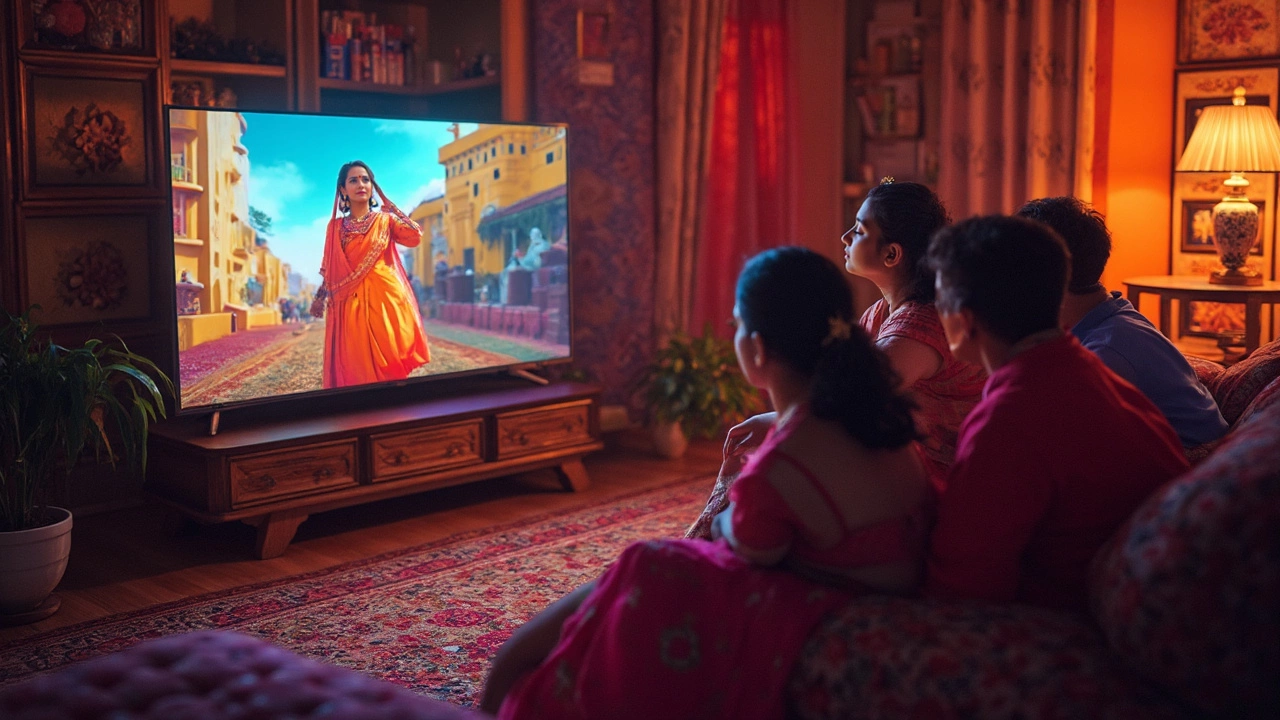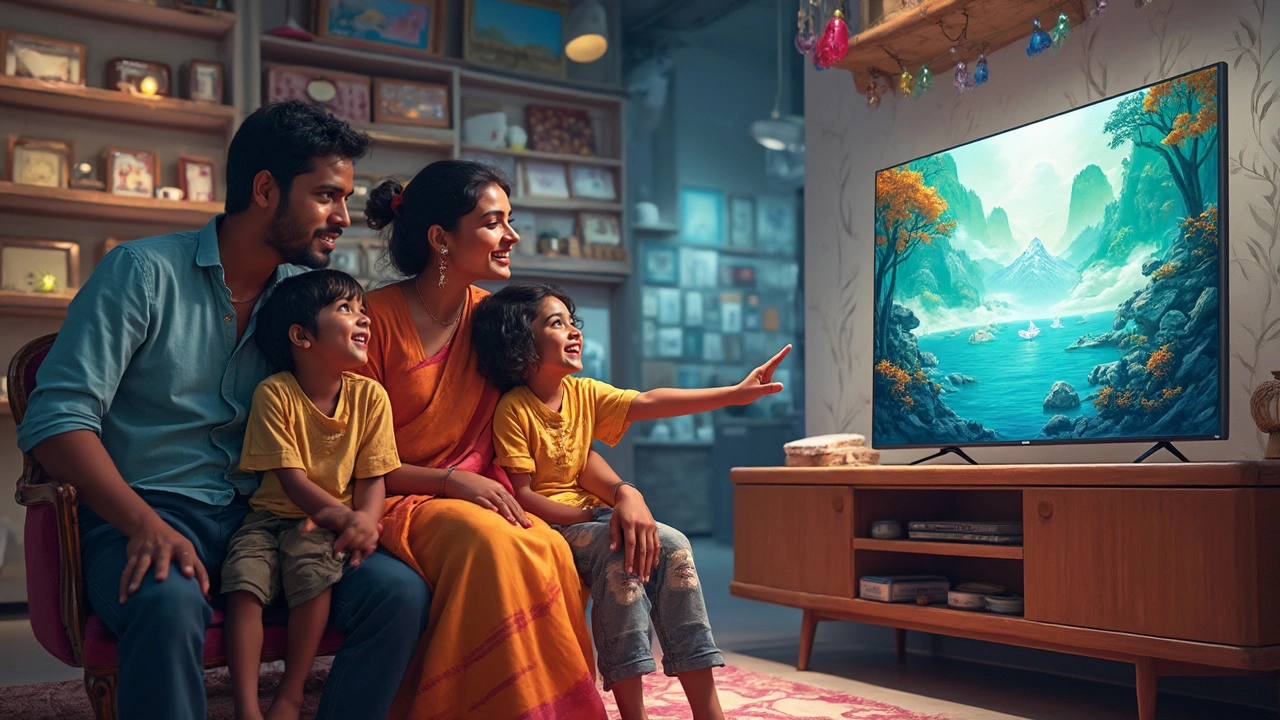
So, you're in the market for a new TV, and you're probably hearing a lot about this QLED thing versus the good old 4K. Confused yet? You're not alone. It's like picking between a fancy coffee machine and one that just brews your plain old drip. Let's break it down a bit.
First off, QLED stands for Quantum Dot Light Emitting Diode, and yeah, it's a bit of a mouthful. But essentially, it means your TV can display brighter, more vivid colors. It's the kind of tech that can make an action movie or a vibrant nature show pop right off the screen.
On the other hand, 4K simply means the resolution – we're talking about four times the pixels of your standard HD. With 4K, imagine seeing every single blade of grass on that football field. It's sharp, it's crisp, and it's pretty swoon-worthy if you ask me.
- Understanding 4K and QLED
- Picture Quality Comparisons
- Tech Features and Benefits
- Price and Value
- Choosing What's Right for You
Understanding 4K and QLED
When you're staring at the TV aisle or scrolling through online options, the terms 4K and QLED pop up a lot. At first glance, they might seem like tech jargon, but they're actually quite straightforward once you know what stands behind those letters.
Let's start with 4K. The '4' refers to approximately 4,000 pixels, translating into a resolution of 3840 x 2160. That's over 8 million pixels, giving you super-clear and detailed images. Think of it as the difference between looking at a print from a regular printer versus one from a high-def photo printer. Everything, from text to textures, becomes crystal clear. It's like cleaning your glasses for the first time after a while.
Now, let's dive into QLED. This is the brainchild of Samsung and stands for Quantum Dot Light Emitting Diode. It sounds fancy because it kind of is. Quantum dots are tiny particles that glow when hit by light, optimizing colors and brightness on your display. So, those vibrant, punchy colors and brilliant whites you see? You can thank the quantum dots for that.
One major aspect where QLED shines is in bright rooms. If your living room has large windows or you love watching daytime TV, a QLED set helps maintain vivid colors and contrast without you having to squint. On the flip side, while 4K dazzles with detail, it doesn't necessarily mean you'll get the enhanced colors as seen with QLED. They both have their standout points.
In a nutshell, if you're all about sharp images, 4K should catch your eye. But if those eye-popping reds and glowing greens are what you crave, QLED might be the tech buddy you want by your side.
Picture Quality Comparisons
Alright, let's talk about what's on the screen. When you compare QLED and 4K, you're really diving into two different aspects of TV picture quality: color richness and resolution sharpness.
With QLED, it's all about those rich, vibrant colors. The technology utilizes tiny particles called quantum dots to enhance brightness and color accuracy. This means you'll see punchier reds, brighter greens, and deep, inky blacks that make a dark room even more immersive. If you're someone who watches a lot of visually dynamic content—think sci-fi movies or animated series—this could be a game-changer.
On the flip side, 4K TVs boast a resolution of 3840x2160 pixels. That’s over 8 million pixels on your screen, offering unbelievably crisp and detailed images. Whether you're binging on documentaries or watching sports, 4K gives you the kind of clarity where you can pick out the strands of an actor's hair or the fine details in a sports player's jersey number.
But here’s the kicker: many high-end QLED TVs also come with 4K resolution. So, you're not just getting those vivid colors but also enjoying the detail-rich quality of 4K. However, not all 4K TVs are QLED, which means they might not offer the same color performance.
Now, what's the downside? Well, QLEDs, with their hyped-up colors, can sometimes oversaturate hues, making them look a bit too intense. On the other hand, traditional 4K’s strength mainly lies in resolution, and it sometimes struggles with color precision in brightly lit rooms.

Tech Features and Benefits
Alright, let's talk tech—because that's where the real magic happens when choosing between QLED and 4K TV. These aren't just fancy words; they actually make a big difference in how you enjoy your shows, movies, or even gaming sessions.
First up, QLED TVs bring in the splash of what they call quantum dots. Sounds sci-fi, right? Basically, these are super tiny things that boost your screen's brightness and color gamut. So, you're getting colors so vivid, they make tropical fish jealous. Also, QLED TVs typically have better peak brightness than other displays—great for those sunny living rooms.
When it comes to 4K TVs, the focus is on resolution. It's all about seeing the tiniest of details clearly. A 4K screen has nearly 8.3 million pixels—that's a ton! This means more detailed and lifelike images, perfect for a rich viewing experience. And did I mention that streaming services like Netflix and Prime Video have a growing library of 4K content you can enjoy?
Now let's look at some specific features. QLED TVs often ship with features like better HDR performance thanks to their higher brightness levels. It means that those shadowy scenes in horror movies have more depth, not just a black blob on the screen. Some models even include smart home controls, so you can adjust the thermostat without leaving the couch.
Most 4K TVs, regardless of whether they're QLED or just standard LED, include smart TV capabilities. We're talking apps, voice controls, and even synchronized experiences with your smartphone. Nice, right? Plus, having a high resolution like 4K means you're set for future content. As more studios start filming in higher resolutions, you're already prepped.
Here's a quick comparison to wrap things up:
| Feature | QLED | 4K |
|---|---|---|
| Color Accuracy | Excellent | Good |
| Brightness | Very High | Moderate |
| Resolution | Same as 4K | 4 times HD |
| HDR Support | Typically better | Good |
| Smart Features | Integrated | Integrated |
Bottom line: If you want the shiniest, brightest colors and your budget allows it, QLED might just be your jam. But if you’re a details person or want a future-proof entertainment hub, a solid 4K TV won’t disappoint.
Price and Value
Alright, let's tackle the nitty-gritty of how much these TVs are gonna set you back. If you've ever wandered the electronics aisle, you know there's quite a spread in TV prices. It's like shoe shopping – luxury brands versus everyday sneakers.
QLED TVs generally come with a higher price tag compared to basic 4K televisions. You're partly paying for the brand and the tech packed in there—especially those quantum dots that make your screen look like a moving painting. Expect to shell out anywhere from $800 to $5,000 depending on the model and size. But remember, the bigger the screen, the deeper you'll have to dig into your wallet.
However, standard 4K TVs have dropped in price over the last few years, thanks to the competition and more models flooding the market. You can snag a decent one for as low as $300. They're budget-friendly but still offer that crisp, clear resolution that makes you feel like you're right there in the scene.
| TV Type | Approx. Starting Price | Approx. Max Price |
|---|---|---|
| QLED | $800 | $5,000 |
| 4K | $300 | $3,000 |
When it comes to getting the best bang for your buck, you have to think about what features matter most to you. If you're all about top-tier color and brightness and don't mind spending a little extra, a QLED might be your winner. But if you're all about saving some cash while still enjoying that sharp image quality, a standard 4K could be more your speed.
Also, consider the long-term investment. Spending more upfront on a QLED could mean enjoying those superior visuals for years to come without the urgent need for an upgrade. With tech always changing, weighing cost versus function is the way to go.

Choosing What's Right for You
Alright, let's get real here. Picking the right TV isn't just about nerding out over specs. It's about what suits your life, your eyes, and yes, your wallet.
Think about where you watch the most TV. Is it a sunlit room? QLED TVs thrive in bright environments with those dazzling colors and enhanced brightness. But if you're setting up a home theater in your den, you might want those deep blacks and finer details, which makes 4K a winner for movie nights.
Then there's your watch list. Are you a sports junkie or a gamer? QLEDs can offer smoother motion thanks to faster refresh rates, which is great for keeping up with fast-moving objects onscreen. But if you're all about those Netflix marathons, 4K's clarity and resolution can truly elevate your viewing experience.
Consider your budget too. QLEDs usually sit at the higher end, but they have models spanning various price ranges now. If testing out the latest tech isn't your thing and you're just looking for solid resolution without breaking the bank, 4K still rocks hard for most daily TV viewers.
Also, don't forget: TV size matters! Larger screens can show off what 4K has to offer since the resolution is more noticeable. Use this table to find a sweet spot between screen size and viewing distance:
| Screen Size (inches) | Optimal Viewing Distance (feet) |
|---|---|
| 40-49 | 3.3 - 4.0 |
| 50-59 | 4.0 - 6.6 |
| 60-69 | 6.6 - 8.3 |
| 70+ | 9.0+ |
Ultimately, whether you sway towards QLED or stick with trusty 4K, remember to choose something that feels right for how you live and watch. After all, it’s about those epic TV moments that you'll enjoy for years to come.